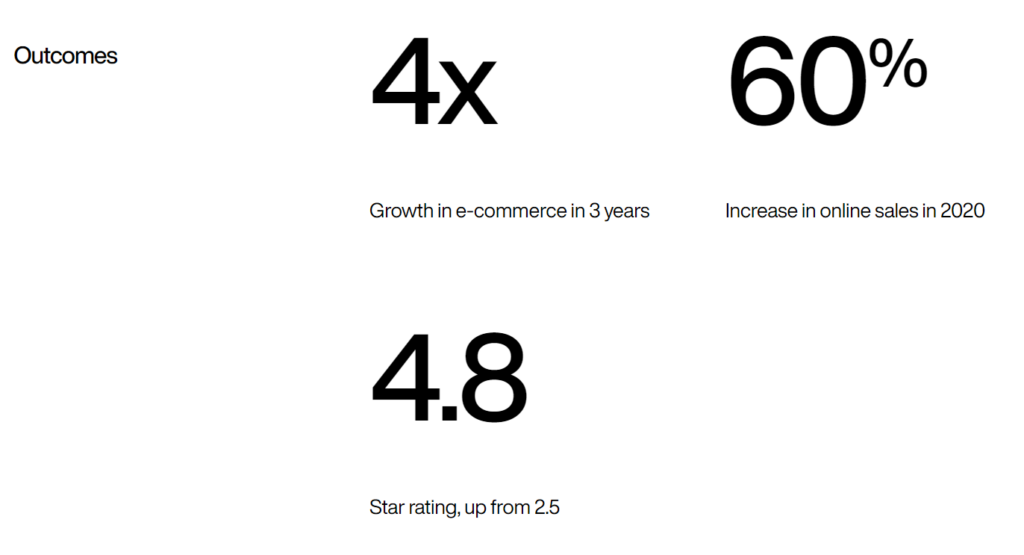Influencer Marketing Hub sets itself apart from conventional review platforms through the involvement of Digital Marketing experts such as Werner Geyser, Djanan Kasumovic, Camille Kennedy, Dave Eagle, and other notable industry figures. This expert team brings a profound understanding of the Digital Marketing landscape, assessing tools and platforms with an insider’s perspective on capabilities, experience, and industry acumen. Unlike user-generated review platforms, Influencer Marketing Hub’s evaluations are rooted in extensive firsthand experience and direct interactions with the tools and platforms in question. This ensures that the reviews are not only trustworthy but also deeply informed. High-caliber brands like Disruptive Advertising, Moburst, and Lyfe Marketing undergo rigorous monthly evaluations, highlighting the platform’s commitment to identifying and showcasing top-tier solutions in Digital Marketing and beyond.
Influencer Marketing Hub has consistently been recognized by leading media outlets for our authoritative data, findings, and insights within the Digital Marketing landscape. Our platform is frequently cited as a trusted source of information, demonstrating the value and impact of our work in shaping industry standards and practices.
Influencer Marketing Hub employs an expert-driven methodology to evaluate Digital Marketing agencies, ensuring that our recommendations are both reliable and comprehensive. This approach is designed to help businesses and individuals find the best agencies to meet their specific Digital Marketing needs. Here’s how we assess the various agencies like Disruptive Advertising, Moburst, and Lyfe Marketing:
Dive into the digital product arena where innovation meets execution. Our expertly curated list spotlights trailblazing agencies that excel in crafting digital products with precision and flair. In a realm where one misstep can derail progress, these agencies stand out for their strategic foresight and creative prowess, ensuring your digital venture is not just a fleeting trend but a market-defining success. Join us as we unveil the agencies responsible for creating cutting-edge solutions.
Top Digital Product Agency Choices
Location: Pleasant Grove, Utah Founded: 2011 Pricing: Minimum campaign size of $5,000, with an average hourly rate between $100 and $149. Disruptive Advertising is your go-to digital product agency for turning advertising into profit. With a keen focus on Pay-Per-Click, conversion rate optimization, and analytics, they ensure your digital products don’t just reach the audience but also resonate with them. Their approach is rooted in data, with a relentless pursuit of optimizing every aspect of the customer journey. Partnering with Disruptive Advertising means benefiting from their expertise in identifying and leveraging the most effective advertising channels for your digital products. Their portfolio, rich with success stories from clients like Guitar Center and Fandango, underscores their prowess in driving growth and improving ROI. Location: New York, New York Founded: 2013 Pricing: Minimum price of $50,000, and the average hourly rate is between $150 and $199. Moburst is a digital product agency specializing in mobile-first experiences, ensuring your product not only enters the market but also conquers it. With a client list that includes giants like Google and Uber, Moburst has proven expertise in launching and scaling digital products. Their data-driven and user-centric approach focuses on maximizing engagement and conversion rates. As you collaborate with Moburst, you’ll leverage their proficiency in app store optimization, mobile strategy, and user acquisition to ensure your digital product stands out. They excel in turning mobile concepts into robust, scalable products. Their campaigns are designed to capture attention and drive action, utilizing the latest in digital marketing techniques and technologies. Their success stories, like the viral campaigns for Samsung and Discovery, highlight their capability to deliver exceptional results. Location: Atlanta, Georgia Founded: 2011 Pricing: Minimum project size starts at $1,000+ with an average hourly rate of $50 – $99/hr. Lyfe Marketing is a digital product agency specializing in creating impactful digital marketing campaigns for small businesses. Their expertise lies in social media management, PPC, SEO, and video production, ensuring your digital products launch successfully and continue to thrive. They pride themselves on delivering affordable and effective marketing solutions that drive growth. Your partnership with Lyfe Marketing will harness their ability to craft targeted campaigns that speak directly to your audience. As a digital product agency, they excel in producing content that engages and converts, leveraging the power of digital platforms to maximize your product’s potential. Their success stories, from increasing leads for dental clinics to boosting eCommerce sales, demonstrate their skill in navigating the digital landscape. Location: Birmingham, Alabama Founded: 2011 Pricing: Minimum project price is $5,000+ with an average hourly rate of $100 – $149 / h. Sociallyin stands out as a digital product agency that breathes social media. They craft strategies and products that ensure your brand not only participates in the conversation but shapes it. With a suite of services that includes everything from social media strategy to influencer marketing, Sociallyin is the partner you need to amplify your digital presence. Your journey with Sociallyin will tap into their expertise in community management, content production, and paid social advertising, ensuring your digital products resonate with your audience. They are a digital product agency that understands the nuances of social platforms, creating campaigns and strategies tailored to each channel’s unique dynamics. Their work with industry leaders across various sectors showcases their ability to drive engagement and deliver tangible results. Location: Dallas, Texas Founded: 2005 Pricing: Minimum project size is $1,000+ with an average hourly rate of $100 – $149 / h. Thrive is a digital product agency that propels your brand forward with a comprehensive suite of digital marketing services. From SEO to content writing, they ensure your digital products gain visibility and traction in a crowded online space. Their strategic approach is designed to increase your digital footprint and drive conversions. As you work with Thrive, you’ll experience their commitment to creating digital products that are not only visually appealing but also optimized for search engines and user experience. They understand the importance of a cohesive digital strategy, integrating various marketing channels to achieve the best results. Their work with clients like Restoration 1 and Driver Support showcases their ability to elevate brands and enhance their digital presence. Location: Brooklyn, NY Founded: 2013 Pricing: Minimum project size start at $5,000+ with an average hourly rate of $100 – $149/hr. At Work & Co, you’ll discover a digital product agency where innovation is the norm and excellence is the standard. With a client roster that reads like a ‘who’s who’ of industry titans, including Apple, Google, and Nike, Work & Co is synonymous with transformative digital experiences. Engaging with Work & Co means entering a space where strategy, design, and technology converge to create digital products that are not only market-leading but also redefine what’s possible. Their products are meticulously tested, user-focused, and designed to evolve with your customers’ needs. Their work, such as the eCommerce hub for Gatorade and IKEA’s digital transformation, is a testament to their ability to meet and exceed their clients’ digital aspirations. Location: Brooklyn, New York Founded: 2003 Pricing: Minimum project size starts at $100,000+ with an average hourly rate of $150 – $199/hr. AREA 17 crafts digital experiences that are aesthetically pleasing and deeply rooted in strategic design. They are in the business of creating work that simplifies complexities and endures over time, serving people, and solving problems through a thoughtful blend of technology and design. As you collaborate with AREA 17, you’ll find their approach is about more than just the end product; it’s about crafting a narrative that resonates with your audience. They’re a digital product agency that believes in the power of storytelling, ensuring every digital product is a reflection of your brand’s identity and values. Their portfolio, featuring collaborations with The New York Times, Balenciaga, and Nike, showcases their prowess in delivering digital solutions that drive engagement and deliver results. Location: New York, New York Founded: 2006 Pricing: Minimum project size starts at $10,000+ with an average hourly rate of $150 – $199/hr. Coalesce specializes in transforming complex problems into user-friendly digital solutions. They have honed the art of simplifying life through digital innovation, whether for businesses, brands, or individuals with bold ideas. Their services include UX/UI design, branding, and web development. But they’re not just building websites; they’re crafting digital experiences that stand out in the crowded digital landscape. Their work, such as the unique eCommerce site for Knopman Marks or the suite of technology for Paperchef, exemplifies their commitment to creating products that are not only visually appealing but also functionally superior. As a digital product agency, Coalesce is recognized for their ability to deliver results, as evidenced by their accolades from Inc Magazine and Expertise.com. Location: New York, New York Founded: 2006 Pricing: Minimum project size starts at $10,000+ with an average hourly rate of $150 – $199/hr. At AMP Agency, your brand’s digital potential is fully realized. As a digital product agency, they excel in creating products that engage and retain your consumer base. AMP Agency leverages a product-centric service design, adeptly crafting mobile applications and interactive installations that resonate with users and elevate brand experiences. Your journey with AMP Agency involves a deep dive into user needs, employing ethnography, surveys, and persona creation to ensure that the digital products developed are innovative. They are an agency that prides itself on a comprehensive suite of services, from strategy and roadmapping to UX and interaction design, all the way through to prototyping and development. Their portfolio showcases their versatility, with notable projects for clients like Microsoft and Real Madrid. Location: San Francisco, California Founded: 2010 Pricing: Minimum project size starts at $75,000+ with an average hourly rate of $150 – $199/hr As a digital product agency, you’ll find Bynd at the intersection of design innovation and technological prowess. Your collaboration with Bynd means tapping into a world-class team that architects, prototypes, and tests digital solutions, ensuring they meet key performance metrics and win markets. Bynd stands out for their customer-centric approach, engineering products that are functional and resonate on a human level. They have demonstrated their expertise through projects like the Global Fibre Impact Explorer, aiding fashion brands in making greener choices and enhancing the Google Partners Directory with a focus on diversity and security.1. Disruptive Advertising

2. Moburst

3. Lyfe Marketing

4. Sociallyin

5. Thrive Internet Marketing Agency

6. Work & Co

7. AREA 17

8. Coalesce

9. AMP Agency
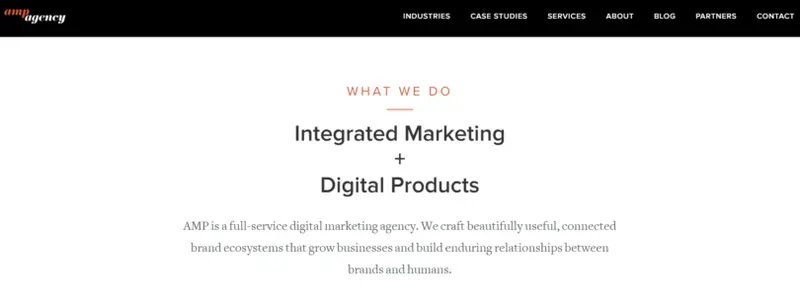
10. Bynd

What Does a Digital Product Agency Do?
Understanding the multifaceted role of a digital product agency can significantly impact the success of your digital projects. These agencies specialize in the end-to-end creation and management of digital products, offering a suite of services that go beyond mere development. This exploration will show why partnering with one might be more advantageous than attempting to navigate the digital landscape on your own.
Strategic Consulting and Market Analysis
A digital product agency begins by aligning your product idea with market needs. Through comprehensive market research and analysis, they identify opportunities, understand your target audience, and craft strategies that ensure your product not only meets but exceeds market expectations.
Take Moburst's approach as an example. The agency specializes in creating mobile-first experiences, and they've previously worked for tech giants like Google and Uber.
Through strategic market analysis, they successfully launched Redefine Meat's product offering across four European countries. Moburst initially developed a strategy to promote Redefine Meat on social media and gained 16 million views on TikTok and 82 million impressions on Facebook, and engagement increased by 15,000% across socials.
Even more so, Moburst was able to develop a waiting list of over 50,000 customers. The campaign was even shortlisted for 11 digital marketing awards. This level of strategic foresight might be hard to achieve on your own without the same level of access to market data and trends.

Redefine Meat case study results
UX/UI Design
The design of your product is crucial to its success. Digital product agencies excel in creating user-centric designs that enhance user experience (UX) and user interface (UI). They employ design thinking methodologies to solve complex problems and ensure your product is not only visually appealing but also intuitive and easy to use.
A compelling example is AMP Agency's work for Slacker Radio, where the challenge was to revamp an existing digital product in a highly competitive market. The agency focused on a complete overhaul of the user interface and experience, aiming to simplify navigation, improve content discovery, and enhance overall user engagement.
The solution involved implementing a more personalized and visually engaging design, which significantly increased user session length and engagement, showcasing the direct impact of thoughtful UX/UI design on product success. The collaboration was so successful that it even received recognition from Time Magazine.
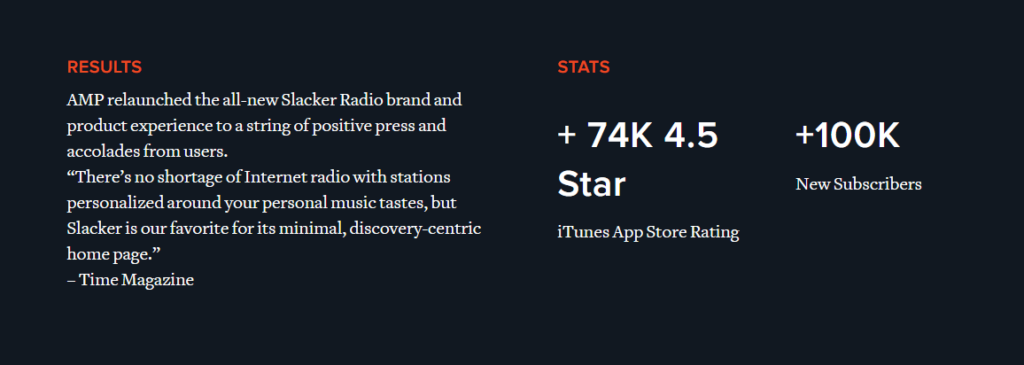
Slacker Radio case study results
Custom Software Development
Whether you're looking to create a web platform, a mobile app, or a SaaS product, digital product agencies have the technical prowess to bring your vision to life. They work with the latest technologies and follow best practices in software development to ensure your product is scalable, secure, and performs seamlessly across all devices and platforms.
That's exactly what Coalesce did for Paperchef, a parchment paper manufacturer struggling with outdated software. The agency was hired for their custom software development and design capabilities, and they got to work developing an ERP system that scales.
One of the system's highlights was the powerful reporting tools that made it easier for Paperchef to access its inventory from anywhere and at any time. Even more so, they implemented design principles to make handling the ERP system a piece of cake. The results were impressive, as detailed in the image below.
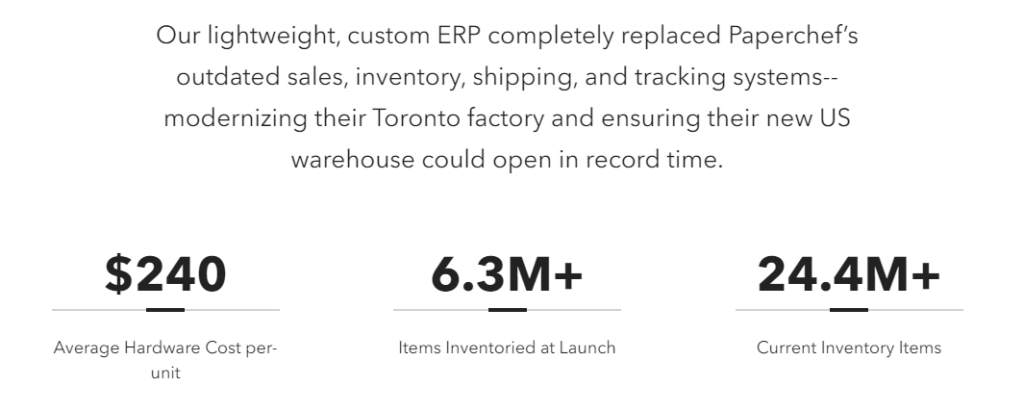
Paperchef case study results
Digital Marketing and SEO
Creating a great product is just the beginning. Digital product agencies also specialize in digital marketing and search engine optimization (SEO) strategies to increase your product's visibility and attract your target audience.
Moburst, an agency we already mentioned, excelled in all things mobile-related. That includes SEO, ASO, mobile strategy development, and more. They combine these services to deliver comprehensive solutions for their clients, starting with the initial product strategy and ending with optimizing for search engines and app stores. This shows us that hiring a digital product agency that can add digital marketing into the mix is crucial for modern success.
Data Analytics and Optimization
Post-launch, digital product agencies don't just move on to the next project. They continuously monitor your product's performance, gather user feedback, and use data analytics to refine and optimize the product. This ongoing optimization ensures your digital product remains relevant and effectively meets user needs. And, again, no agency from our list better exemplifies this than Moburst.
By leveraging advanced analytics and business intelligence, Moburst goes beyond traditional metrics to uncover deep insights into user behavior and product performance. Their strategic approach to data-driven optimization has consistently led to enhanced user experiences and increased ROI for their clients, proving the indispensable value of informed analytics in the digital product lifecycle.
Choosing to partner with a digital product agency offers a comprehensive approach to digital product development and management. Their expertise across strategy, design, development, marketing, and analytics can significantly enhance the quality and success of your digital product. While it might seem feasible to tackle these aspects on your own, the depth of knowledge, skills, and resources that these agencies bring to the table can save you time and money in the long run, and ultimately deliver a product that stands out in the digital marketplace.
Key Considerations for Selecting the Right Digital Product Agency
Choosing the right digital product agency is a pivotal decision that requires careful consideration of various factors to ensure the agency aligns well with your business goals and vision. Below is an outline of essential aspects, distilled from industry insights and professional recommendations:
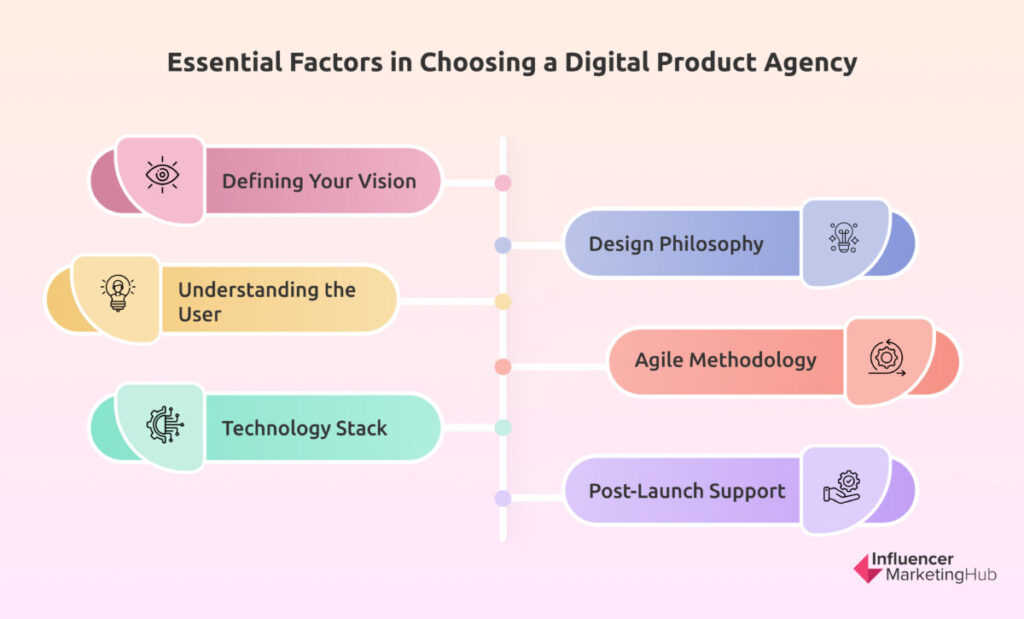
Defining Your Vision
Establishing a clear vision for your digital product is crucial. The ideal agency will not only grasp your vision but will also enhance it, ensuring it remains relevant amidst evolving market trends and technological advancements.
This includes:
- Engaging in deep discussions to fully understand your objectives
- Being open about their strengths and how they align with your project, and showcasing a history of stable relationships with both clients and their team
- Indicating reliability and consistency
Understanding the User
The importance of recognizing and understanding your target users cannot be overstressed. A skilled agency employs comprehensive user research techniques to explore the needs and preferences of your audience, guaranteeing that the final product genuinely engages its users.
For example, Work & Co specializes in developing user-focused digital products, ranging from full-stack mobile and web solutions to LLMs (large language models). Their methodology is centered around deep user engagement from the outset, employing a variety of research methods such as interviews, surveys, usability testing, and data analysis to gain insights into user behavior, preferences, and pain points. This user-centric approach ensures that the solutions developed are not only technologically advanced but also highly relevant and intuitive for the end user.
Technology Stack
The technological foundation of your project is pivotal. It's crucial to partner with an agency that not only has proven expertise in the required technology stacks but also communicates their development methodologies transparently and shows adaptability in tailoring their strategies to fulfill client requirements, guaranteeing the efficient and impactful realization of your vision.
Design Philosophy
Agile Methodology
Post-Launch Support
Selecting the right digital product agency is a strategic decision that demands thoughtful consideration of these critical factors. By focusing on these key elements, you can forge a partnership that not only brings your digital product to life but also ensures its long-term success and adaptability in the ever-evolving digital landscape. Choose wisely to ensure your vision becomes a reality with the right support and expertise.
Methodology
Our rigorous selection process for the top digital product agencies is underpinned by an exhaustive analysis of industry metrics and qualitative insights. We've meticulously reviewed over 14000 agencies, drawing upon our team's six-plus years of expertise in digital marketing and a wealth of knowledge from crafting over 3000 articles. Our criteria span a spectrum of core competencies, including innovation, user experience design, technological prowess, and client feedback. We've also weighed the agencies' strategic approaches to project management, adaptability to market shifts, and their track record of delivering transformative digital solutions. This holistic methodology ensures our list reflects a blend of empirical data and nuanced industry understanding, providing a reliable guide for businesses seeking exceptional digital product services. Our commitment to this thorough evaluative approach stems from our extensive experience and dedication to the digital marketing realm.
Conclusion
Selecting a digital product agency is a pivotal decision that shapes your brand's trajectory. The agencies featured by our experts are the crème de la crème, recognized for their innovative solutions and ability to sidestep the industry's common pitfalls. They are not just service providers but visionary partners who will propel your brand to the forefront of the digital revolution.
Frequently Asked Questions
What is a Digital Product Agency?
A digital product agency specializes in bringing digital products to life, ranging from websites and apps to software programs. They cater to businesses of all sizes, guiding them through digital transformation with scalable software solutions and comprehensive teams that may include coaches, designers, and developers. These agencies differ from traditional marketing or IT agencies by focusing on a complete lifecycle of product development, from ideation to execution and beyond.
How Do I Choose the Right Digital Product Agency for My Business?
Choosing the right digital product agency involves understanding your specific needs and budget first. Demand full transparency and look for agencies with a clear address, bios, and client list on their website. Check their credibility through client testimonials and references, including those from less successful engagements. Experience in your industry is beneficial but not mandatory; a fresh perspective can be just as valuable.
What Are the Benefits of Working with a Digital Product Agency?
Working with a digital product agency gives you access to specialized expertise across various disciplines without the need for in-house hiring. They provide high-quality outcomes within shorter timelines, thanks to their interdisciplinary teams and efficient processes. Agencies assist in crafting both short- and long-term product strategies, ensuring a high ROI and alignment with business objectives.
How Much Does It Cost to Hire a Digital Product Agency?
The cost of hiring a digital product agency can vary widely, from a few thousand dollars to hundreds of thousands, depending on project scope and complexity. Agencies may charge a fixed fee or an hourly rate. It's essential to request quotes from multiple agencies to compare pricing and services, ensuring you find the best fit for your budget and needs.
What Should I Expect When Working with a Digital Product Agency?
When engaging with a digital product agency, expect a collaborative process that typically includes stages of discovery, strategy, design, development, and deployment. Agencies should communicate regularly and keep you involved throughout the process, with transparency in their operations and a clear understanding of your business goals and user needs. Post-launch, anticipate ongoing support and maintenance to ensure your digital product remains current and functional.





